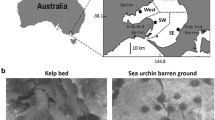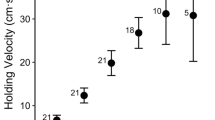Abstract
Regulating mobility by actively entering the drift under imminent predation risk is an avoidance strategy employed by aquatic macroinvertebrate species that is widely accepted within the scientific community. This response was most evident with respect to diurnal predators that feed in the water column, such as many salmonids. We investigated the role of the nocturnal benthivorous gudgeon [Gobio gobio (L.)] on the drift activity of two macroinvertebrate species known to display this behaviour: Baetis rhodani (PICTET) and Gammarus pulex (L.). Laboratory drift experiments using gudgeon kairomones were conducted with the results determining significant altered activity in the presence of gudgeon kairomones for both macroinvertebrate species. B. rhodani showed reduced drift activity in the kairomone treatment compared to the kairomone-free control, with a distinct nocturnal pattern being observed for both. G. pulex shifted from a similar day/night movement pattern to a nocturnal movement pattern with decreased activity during the day. Reduce activity during the day, whilst maintaining normal activity at night would not reduce the probability of encountering a nocturnal predator under natural conditions and therefore appears to not be a meaningful anti-predator response. To assess the relevance of these findings under natural conditions, we compared the experimental results with drift measurements from field observations. These show a significant reduction in drift activity for G. pulex and slight tendencies for reduced night-time drift for B. rhodani, under seasonal variations. We conclude that the behaviour in response to the physical contact or the hydrodynamic stimuli of nocturnal predators is the most likely explanation for the differences between the results from our laboratory experiment and the field observation. We further discuss that the observed migration patterns might have different species specific consequences for density stabilisation on a population level.



Similar content being viewed by others
References
Abjörnsson K, Hansson LA, Bronmark C (2004) Responses of prey from habitats with different predator regimes: local adaptation and heritability. Ecol 85:1859–1866
Allan JD (1978) Trout predation and the size composition of stream drift. Limnol Oceanogr 23:1231–1237
Andersson KG, Bronmark C, Herrmann J, Malmqvist B, Otto C, Sjostrom P (1986) Presence of sculpin (Cottus gobio) reduces drift and activity of Gammarus pulex (Amphipoda). Hydrobiologia 133:209–215
Anholt BR (1995) Density dependence resolves the stream drift paradox. Ecol 76:2235–2239
Bohle HW (1978) Beziehungen zwischen dem Nahrungsangebot der Drift und der räumlichen Verteilung bei Larven von Baetis rhodani (PICTET) (Ephemeroptera Baetidae). Untersuchungen in künstlichen Fließwasseranlagen. Arch Hydrobiol 84:500–525 (in German)
Crawley MJ (2002) Statistical computing: an introduction to data analysis using S-Plus, 1st edn. Wiley, New York, p 761
Culp JM, Glozier NE, Scrimgeour GJ (1991) Reduction of predation risk under the cover of darkness: avoidance responses of mayfly larvae to a benthic fish. Oecologia 86:163–169
Dahl J (1998) Effects of a benthivorous and a drift-feeding fish on a benthic stream assemblage. Oecologia 116:426–432
Elliott JM (1971) Upstream movements of benthic invertebrates in a Lake District stream. J Anim Ecol 40:235–252
Englund G (2005) Scale dependent effects of predatory fish on stream benthos. Oikos 111:19–30
Englund G, Olsson T (1996) Treatment effects in a stream fish enclosure experiment: influence of predation rate and prey movements. Oikos 77:519–528
Friberg N, Andersen TH, Hansen HO, Iversen TM, Jacobsen D, Krojgaard L, Larsen SE (1994) The effect of brown trout (Salmo trutta L) on stream invertebrate drift, with special reference to Gammarus pulex L. Hydrobiologia 294:105–110
Heise BA (1992) Sensitivity of mayfly nymphs to red light implications for behavioural ecology. Freshw Biol 28:331–336
Hildebrand S (1974) The relation of drift to benthos density and food level in an artificial stream. Limnol Oceanogr 19:951–957
Hughes DA (1970) Some factors affecting drift and upstream movements of Gammarus pulex. Ecol 5:301–305
Huhta A, Muotka T, Juntunen A, Yrjönen M (1999) Behavioural interactions in stream food webs: the case of drift-feeding fish, predatory invertebrates and grazing mayflies. J Anim Ecol 68:917–927
Huhta A, Muotka T, Tikkanen P (2000) Nocturnal drift of mayfly nymphs as a post-contact antipredator mechanism. Freshw Biol 45:33–42
Humphries S, Ruxton GD (2002) Is there really a drift paradox? J Anim Ecol 71:151–154
Kopp M, Jeschke JM, Gabriel W (2001) Exact compensation of stream drift as an evolutionary stable strategy. Oikos 92:522–530
McIntosh AR, Peckarsky BL (1996) Differential behavioural responses of mayflies from streams with and without fish to trout odour. Freshw Biol 35:141–148
McIntosh AR, Peckarsky BL (2004) Are mayfly anti-predator response to fish odour proportional to risk? Arch Hydrobiol 160:145–151
McIntosh AR, Peckarsky BL, Taylor BW (1999) Rapid size-specific changes in the drift of Baetis bicaudatus (Ephemeroptera) caused by alterations in fish odour concentration. Oecologia 118:256–264
McIntosh AR, Peckarsky BL, Taylor BW (2002) The influence of predatory fish on mayfly drift: extrapolating from experiments to nature. Freshw Biol 47:1497–1513
Meijering MPD (1972) Experimentelle Untersuchung zur Drift und Aufwanderung von Gammariden in Fließgewässern. Arch Hydrobiol 70:133–205. (in German)
Miyasaka H, Nakano S (1999) Effects of drift- and benthic-foraging fish on the drift dispersal of three species of mayfly nymphs in a Japanese stream. Oecologia 118:99–106
Miyasaka H, Nakano S (2001) Drift dispersal of mayfly nymphs in the presence of chemical and visual cues from diurnal drift- and nocturnal benthic-foraging fishes. Freshw Biol 46:1229–1237
Newman RM, Waters TF (1984) Size-selective predeation on Gammarus pseudolimnaeus by trout and sculpins. Ecology 65:1535–1545
Peckarsky BL (1996) Alternative predator avoidance syndromes of stream-dwelling mayfly larvae. Ecology 77:1888–1905
Peckarsky BL, McIntosh AR (1998) Fitness and community consequences of avoiding multiple predators. Oecologia 113:565–576
R Development Core Team (2010) R: a language and environment for statistical computing. R Foundation for Statistical Computing, Vienna, Austria. ISBN:3-900051-07-0. http://www.R-project.org
Schmidt SI, Koenig-Rinke M, Kornek K, Winkelmann C, Wetzel MA, Koop JHE, Benndorf J (2009) Finding appropriate reference sites in large-scale aquatic field experiments. Aquat Ecol 43:169–179
Schwoerbel J (1994) Methoden der Hydrobiologie (Süßwasserbiologie). 4. Auflage, Gustav Fischer Verlag Stuttgart Jena (in German)
Tikkanen P, Muotka T, Huhta A (1994) Predator detection and avoidance by lotic mayfly nymphs of different size. Oecologia 99:252–259
Venables WN, Ripley BD (2002) Modern applied statistics with S, 4th edn. Springer, New York
Williams DD, Moore KA (1982) The effect of environmental factors on the activity of Gammarus pseudolimnaeus (Amphipoda). Hydrobiologia 96:137–147
Williams DD, Moore KA (1985) The role of semiochemicals in benthic community relationships of the lotic Amphipod Gammarus pseudolimnaeus: a laboratory study. Oikos 44:280–286
Winkelmann C, Worischka S, Koop JHE, Benndorf J (2007) Predation effects of benthivorous fish on grazing and shredding macroinvertebrates in a detritus-based stream food web. Limnologica 37:121–128
Winkelmann C, Petzold T, Koop JHE, Matthaei CD, Benndorf J (2008) Benthivorous fish reduce stream invertebrate drift in a large-scale field experiment. Aquat Ecol 42:483–493
Worischka S, Köbsch C, Hellmann C, Winkelmann C (2012) Habitat overlap between benthic fish predators and their invertebrate prey in streams – The influence of spatial versus temporal factors on predation risk. Freshw Biol 57:2247–2261
Acknowledgments
We want to dedicate this article to our teacher and mentor Prof. Jürgen Benndorf who died in 2011 suddenly and unexpectedly. We would like to thank Kerstin Flemming for helping during the laboratory experiments with the gammarids, Andrew Kaus for linguistic support and two anonymous reviewers for their constructive comments. This research was supported by the German Research Foundation (grant BE 1671/9-1).
Author information
Authors and Affiliations
Corresponding author
Additional information
Handling Editor: Michael T. Monaghan
Rights and permissions
About this article
Cite this article
Schäffer, M., Winkelmann, C., Hellmann, C. et al. Reduced drift activity of two benthic invertebrate species is mediated by infochemicals of benthic fish. Aquat Ecol 47, 99–107 (2013). https://doi.org/10.1007/s10452-013-9428-1
Received:
Accepted:
Published:
Issue Date:
DOI: https://doi.org/10.1007/s10452-013-9428-1




